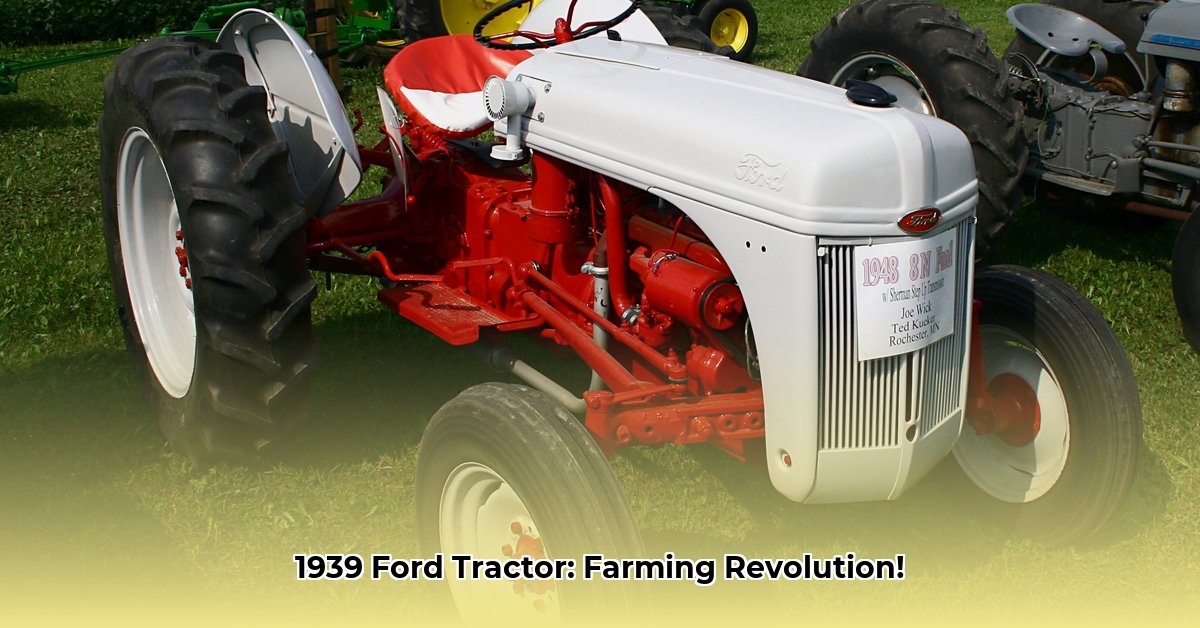
A Giant Leap for Agriculture
Imagine the backbreaking labor of pre-mechanized farming. Then, picture the 1939 Ford tractor arriving—not just any tractor, but a game-changer. This machine ushered in a new era of efficiency, leaving an indelible mark on American agriculture and beyond. The 1939 Ford 9N, in particular, stands out for its revolutionary feature: the Ferguson three-point hitch (a system for easily attaching and using farming implements). This innovation dramatically simplified farming operations. Was this a simple improvement, or something truly transformative? The answer is clear in the millions of acres it helped cultivate. For more details on Ford N-series tractors, visit this helpful site.
The 9N: A Revolutionary Design
The 9N wasn't just powerful; its design was ingenious. Ford cleverly utilized readily-available automotive parts, significantly reducing production costs and making repairs simpler and cheaper for farmers. This accessibility was key to its widespread adoption. This wasn't merely cost-cutting; it was about democratizing mechanized farming. The 9N’s sleek cast aluminum grille lent a touch of style to its functional design, showcasing Ford’s attention to detail.
Wartime Adjustments: The 2N
World War II brought unprecedented challenges. The 2N, produced during this period, reflects the realities of wartime limitations. Material scarcity forced design compromises, yet the 2N maintained its core functionality. This adaptability is a testament to clever engineering, ensuring continued food production despite severe restrictions. What ingenious solutions did Ford engineers employ during this critical time? This adaptability was key to keeping food production alive on the home front.
The 8N: A Lasting Legacy
The 8N, building upon its predecessors’ successes, achieved remarkable popularity. Over 530,000 units were sold globally, a testament to its desirability and effectiveness. This wasn't simply popularity; it signified a new standard in farm machinery. The 8N became synonymous with reliability, efficiency, and practicality for generations of farmers. What features made the 8N so remarkably successful, and why is it still coveted by collectors today? Its enduring influence on farming practices is remarkable.
A Partnership Turned Sour
The Ford N-Series story isn't solely about innovation; it’s also about conflict. The partnership between Henry Ford and Harry Ferguson, initially highly productive, ultimately dissolved in a storm of patent disputes and legal battles. Yet, the tractors' legacy endures, a testament to the fact that even amidst conflict, progress can prevail. The lasting impact of their combined work is visible in the fields and collections around the world — a reminder of how great achievements can emerge even from contentious collaborations.
The Long-Term Impact: Beyond the Farms
The Ford N-Series tractors fundamentally altered farming practices, leading to increased crop yields and efficiency. They transformed the lives of countless farmers. Their lasting appeal is evident in the vibrant collector community that cherishes these machines as symbols of history. How did these tractors significantly impact the social fabric of rural America and beyond? Their influence stretches far beyond the farm, shaping our understanding of both agricultural technology and American ingenuity.
Key Features: A Side-by-Side Comparison
| Feature | 9N (1939 Ford Tractor) | 2N | 8N |
|---|---|---|---|
| Engine | Original 9N Ford Engine | Wartime Modifications | Enhanced 8N Engine |
| Materials | Aluminum and Steel | Wartime Substitutions | Refined Materials |
| Three-Point Hitch | First Implementation | Maintained | Improved Design |
| Production Years | 1939-1941 | 1942-1947 | 1947-1952 |
The legacy of the 1939 Ford tractor and its successors is one of groundbreaking innovation, conflict, and enduring success. They represent a pivotal shift in farming and the enduring power of well-engineered design. Their story continues to inspire and captivate, underscoring the potential of human ingenuity and the timeless appeal of expertly crafted machinery.
How Did WWII Impact Ford 2N Tractor Design Choices?
World War II profoundly reshaped American agriculture, and the Ford 2N tractor felt its impact directly. The 2N, a successor to the 9N, was more than just farm equipment; it embodied Ford's forward-thinking vision for mechanized farming.
Resource Constraints and Design Compromises
The war brought drastic material shortages. Steel, rubber, and other essential components became scarce as production shifted to war materials. This scarcity forced Ford to make difficult choices. The 2N’s design reflects these compromises. To conserve vital resources, Ford sometimes used steel wheels instead of rubber tires, impacting a farmer's daily operations. Electric starters were sometimes replaced by hand cranks. These weren't aesthetic choices; they were survival strategies.
Production Prioritization and Allocation
Wartime production prioritized military needs. Tractor production, while crucial for food security, was subject to strict government regulations and quotas, both in terms of quantity and types of tractors. The 2N's relative simplicity aided its faster production under these conditions. Did this impact its quality? While some argue for a slight reduction in luxury features, its functionality remained paramount.
The Post-War Boom and the Legacy of the 2N
Post-war, pent-up demand surged. The 2N, with its reliability and simple design, was highly sought after. Its simpler design also made repairs more accessible. The 2N's post-war success showcases its adaptability and relevance to changing needs. Its endurance was a testament to both its design and the enduring need for robust farm machinery across the evolving landscape of American agriculture.
Key Takeaways:
- WWII severely impacted the availability of essential materials, necessitating design compromises in the Ford 2N.
- Government regulations and wartime production priorities significantly affected tractor production.
- The 2N's simpler design proved advantageous, streamlining production and simplifying repairs.
- Post-war demand highlighted the importance of agricultural machinery in national recovery.
- The 2N demonstrates how wartime pressures can shape industrial design, leaving a lasting impact on technology and manufacturing.